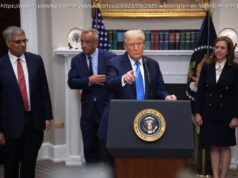WASHINGTON — President Trump frequently talks about reviving the American auto industry, but his approach to trade policy may backfire on the country’s carmakers. Trump’s…
WASHINGTON — President Trump frequently talks about reviving the American auto industry, but his approach to trade policy may backfire on the country’s carmakers.
Trump’s efforts to renegotiate the North American Free Trade Agreement, to impose tariffs on imported aluminum and steel and to reduce the U. S. trade deficit with China could limit the reach of companies that produce cars in the United States and depend on access to growing markets outside the country.
On Friday, the chief executives of the biggest automakers plan to meet with the president at the White House. The gathering comes at a critical moment, as Trump administration officials race to finalize a NAFTA rewrite in the next few weeks and prepare to meet again next week with Chinese leaders in hopes of forestalling a potential trade war.
The auto industry is among the sectors most vulnerable to trade disruptions because its business model is increasingly global, in terms of both production and sales. One in five cars made in the United States is now exported, and 1 in 4 vehicles sold in the U. S. were produced in factories run by foreign-owned companies. General Motors sold nearly 1 million vehicles in China in the first quarter of the year — more than it sold in North America in the same period.
In the past two decades, U. S. automakers have set up plants in Canada, China and Mexico, and they routinely import car parts from other countries. Mexico has added hundreds of thousands of auto-making jobs since NAFTA’s enactment in 1994, while the United States has lost hundreds of thousands.
Labor groups and administration officials are hopeful that the trade moves will change incentives to encourage domestic and foreign-owned carmakers to manufacture more of their vehicles in the United States. But industry representatives warn that proposals now being championed by the Trump administration could have the opposite effect, raising the prices of U. S.-made cars and trucks, reducing vehicle sales and potentially choking off access to China, the world’s fastest-growing market for automobiles.
“There are so many fronts open that introduce risk into the autos’ business, and the suppliers’ business, that I don’t know how you do any business planning at all right now,” said Kristin Dziczek, vice president for industry, labor and economics at the Center for Automotive Research in Michigan. “They’re playing with big money and big risk and big companies that employ a lot of people.”
The biggest risk may relate to the rewriting of NAFTA, a drawn-out process beset by disagreements between Canada, Mexico and the United States, and punctuated by Trump’s repeated threat to withdraw from the deal if it is not revised in the United States’ favor. Those threats have spooked automakers, whose fortunes are closely tied to the ways the accord has allowed them to reduce the cost of production and parts.
Negotiators have moved closer to agreement, but there are still big disagreements — particularly over the issue of auto manufacturing — that could scuttle the deal entirely or delay it so long that the Republican-controlled Congress is denied the opportunity to approve the revisions quickly.
One of the biggest sticking points relates to the portion of a car that must be made in North America to qualify for NAFTA’s zero tariffs. U. S. automakers support high levels of North American production, but they do not want onerous requirements that prevent them from using products from Mexico or countries like China and Japan. Automakers have warned that the administration’s demands would be expensive to comply with, and could push them to move some production out of North America altogether.
Administration officials initially demanded that 85 percent of a car’s content come from North America, but they have dropped the requirement to 75 percent in the latest round of talks, which are going on this week. That is still above the current threshold of 62.5 percent and beyond the 70 percent level that Mexico is demanding.
Administration officials also want at least 40 percent of every vehicle to be manufactured by workers earning at least $16 an hour, a potential blow to Mexico, where wages are lower, that could benefit workers in the United States if it discouraged carmakers from shifting jobs to Mexico.
Dziczek and her colleagues at the automotive research center said that the proposed NAFTA rule changes could subject 25-87 percent of vehicles sold in the United States to new tariffs, raising the price of those vehicles by $470 to $2,200 each. A report by the center warns that such increases would reduce annual auto sales in the United States by 60,000 to 150,000.
Manufacturing trade groups have warned about the risks of the administration’s approach, but auto executives have stayed quiet publicly on trade issues, in part to avoid antagonizing officials in any of the countries where they depend on for sales.
“There is a lot of risk” for automakers in the current trade environment, said John Bozzella, a former Chrysler executive and the president and chief executive of the Association of Global Automakers, a Washington trade group for foreign-owned carmakers including Toyota and Nissan. “In all of these, you see the potential in raising production costs on vehicles built in the United States. And not just vehicles for trade.”
The tariffs on steel (25 percent) and aluminum (10 percent) are also a looming threat to the automakers’ profitability, given that American companies rely on products from countries like Japan and China that are not exempt from the levies. The Trump administration has temporarily exempted the European Union, Canada and Mexico from the tariffs until June 1, and officials have said they will only make the exemptions permanent if the affected countries voluntarily lower the amount of metals they export to the United States.
In 2017, the Ford Mustang, assembled in the United States, got 52 percent of its parts from the United States and Canada, according to statistics from the National Highway Traffic Safety Administration. The Dodge Charger, assembled in Canada, got nearly a quarter of its parts from Mexico, including the engines in some of its models, although the 3.6-liter version is made in the United States. The Honda Accord, which is assembled in the United States, includes 70 percent U. S. and Canadian content, and 15 percent from Japan.
Asked about Trump’s tariffs on an earnings call, Ford’s president and chief executive, James Hackett, said he had told world leaders that “what we crave as business people are certainty and equilibrium.






